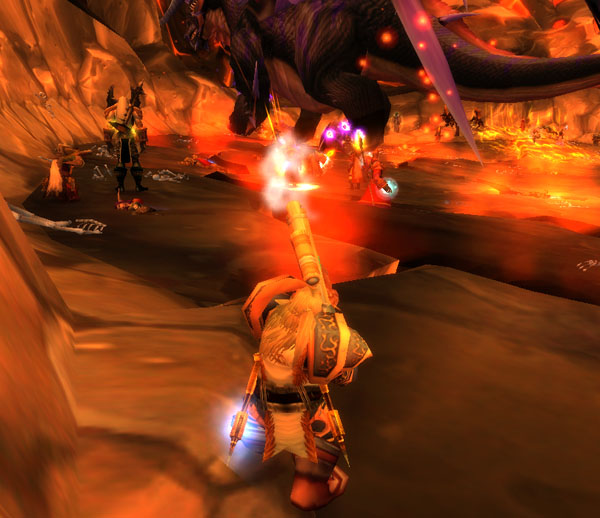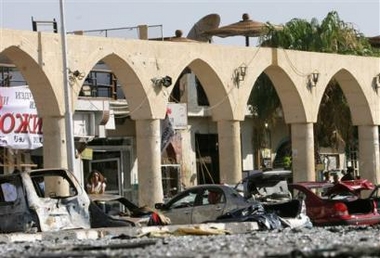


Capitol Records released a sampler of Liz Phair’s new album, “Somebody’s Miracle,” a few weeks ago, but then took it down. Naturally, at least one fan has posted it for those who missed it, like me. (Update: The album’s out. Stop eating that guy’s bandwidth!)
None of the five tracks are complete versions of the songs — the longest checks in at only two minutes and 10 seconds — but they give a feel for what the album will be like.
Still no sign of her podcast, and only this could be found online from an official source talking about it. I hope she hasn’t abandoned the idea.
Originally spotted at Augie’s blaugie: Novelist C. J. Cherryh on what not to do as a writer.
Fairly technical, but a highlight:
florid verbs. “The car grumbled its way to the curb” is on the verge of being so colorful it’s distracting. {Florid fr. Lat. floreo, to flower.}
If a manuscript looks as if it’s sprouted leaves and branches, if every verb is “unusual,” if the vocabulary is more interesting than the story … fix it by going to more ordinary verbs. There are vocabulary-addicts who will praise your prose for this but not many who can simultaneously admire your verbs as verbs and follow your story, especially if it has content. The car is not a main actor and not one you necessarily need to make into a character. If its action should be more ordinary and transparent, don’t use an odd expression. This is prose.
This statement also goes for unusual descriptions and odd adjectives, nouns, and adverbs.
OK, everyone who had “five years” in the pool, you lose. After six years of marriage, Jenn still hasn’t kicked me out or suffocated me with a pillow (yet). To celebrate, the plan, I think is, Johnny Carino’s in Victorville.
And, of course, nothing says “romance” like getting together with 38 other geeks to fight a dragon the size of a Wal-Mart in World of Warcraft.

Happy anniversary, bebe.

This is horrifying:
A rapid series of car bombs and another blast ripped through a luxury hotel and a coffeeshop in the Egyptian Red Sea resort of Sharm el-Sheik early Saturday, killing at least 83, a hospital official said. Terrified European and Arab tourists fled into the night, and rescue workers said the death toll could still rise.
The attack, Egypt’s deadliest terror hit ever, appeared well coordinated. Two car bombs, possibly by suicide attackers, went off simultaneously at 1:15 a.m. just more than 2 miles apart. A third bomb, believed hidden in a sack, detonated around the same time near a beachside walkway where tourists often stroll at night.
I dived at Sharm in the mid-1990s when I lived in Egypt, and it is (or at least was at that time) a tiny village on the coast of the Red Sea. Even “village” overstates how small it is — it’s certainly not the size of something Westerners would think of as a resort. These attacks had to have been devastating.
Sharm caters to scuba divers, especially from Europe and America. (Cousteau once said the Red Sea is the greatest diving in the world, and it’s hard to argue with him.) When Egypt was hit by terrorism in the 1990s, also directed at tourism, which provides nearly all of Egypt’s revenue, it had horrible effects for the country and its economy — and this in a country where, even during the good times, many Egyptians have a quality of life that Americans would see as far, far below the poverty line.
The country (with American help) responded by hitting back brutally at the (mostly) homegrown terrorists. That worked, for a while at least. I suspect that Al-Qaeda has just bitten off a lot more than they can chew here and will, in the end, get chased out of Egypt, and rightly so. But American (and Egyptian) hopes for real democracy in Egypt will likely be a casualty along the way, again.
Contrary to what many Americans believe, Egyptians tend to love Americans. You don’t have to tell someone without a real democracy that disliking a nation’s politics doesn’t mean much about how you feel about a citizen of that country, and Egyptians can easily separate Americans from the American government’s policies. As a consequence, they gobble up America with a fork, whether it’s endless movies and television shows (“The Bold & The Beautiful” was the #1 show when I lived in Egypt, and its stars were treated like royalty whenever they visited), American fast food (two hour lines in the hot Egyptian sun to get McDonald’s, if you can imagine it) and America’s values.
Americans who like to tell people they love our freedom are like a fish saying it likes water: If you’re raised in that environment, it’s hard to know what the rest of the world is really like. I had a Cairo cabbie once stop the cab, turn around and tearfully quote large portions of the Declaration of Independence to me, finishing by pointing his finger at the sky and say “I love America! I love that system!” Ask someone who’s never been free, but has watched it from afar, what freedom and democracy are worth.
The attack on Sharm was an attack on Egypt, for all that the bombs were used in a tourist locale. Dead Westerners are certainly something Al-Qaeda would be happy about, but forcing a confrontation with Egypt that radicalizes Egyptians is also part of their long-term agenda.
Egyptians are a friendly, sweet, wonderful, warm people. They don’t deserve any of this. I mourn the dead and I mourn the living victims, too.
According to the Christian Science Monitor, support for terrorist tactics is down in the Muslim world. The Pew Research poll isn’t as complete as I’d like (I suspect they weren’t able to conduct polls in all the relevant countries, like Egypt), but still an interesting read.
Journalists, including ones who work for the LA Times, sometimes seem to live in a separate world from everyone else, especially when it comes to looking at their own paper’s problems.
Here’s John Carroll, who’s stepping down as editor-in-chief of the LA Times, on why circulation for the paper is declining:
Paul McLeary: One of the reasons the Los Angeles Times represents a puzzling — even disturbing — case study for the rest of us is the striking disparity between its journalistic performance (13 Pultizer prizes in five years) and its circulation performance (daily readership down 6.5 percent and Sunday readership down 7.9 percent in just the past 12 months). You must have felt at times like the gladiator who keeps vanquishing foes in the arena, yet every time he looks up at the bleachers, people are filing out the exits. As the guy who lived that paradox, do you have any insights into it to share?
John Carroll: I believe content had nothing to do with the circulation decline; if anything, the decline was mitigated by our content. Where does the blame lie? The list is long: 1. The scandal at Newsday, which prompted both our internal auditors and the Audit Bureau of Circulation to disallow certain types of sales that were previously considered legitimate. 2. The advent of the “do not call” list, which stymied our phone sales. 3. The reduction of the newspaper’s cost base by more than $130 million annually, which cut the strength of marketing and promotion efforts, among others. 4. Issues on the business side that recently prompted the appointment of new directors of circulation and marketing. 5. And, of course, increased competition for readers’ time. That’s only a partial list.
It’s not even on his radar that the paper feels incredibly irrelevant to many Angelenos, despite the fact that the LA Times’ circulation numbers are dropping faster than the competing papers’ are.
Let’s be honest here: Angelenos know where to find the LA Times. They know how to get a subscription if they want one. Telemarketers being rebuffed by the do not call lists should have only the slightest dent in circulation numbers. People aren’t reading the LA Times because they don’t want to. And that, Mr. Carroll, is absolutely all to do with content.
“Increased competiton for readers’ time” is publishing speak for “Internet,” and it’s the same sort of nonsensical boogeyman Old Media heads have been trotting out since the World Wide Web made its debut. Because, despite the fact that newspapers use text and static images, the two forms of media most easily placed on the Internet, the old guard has remained wedded to distributing their content on recycled pulp instead of rising to meet the challenges of the Internet.
Of course, that’s hardly surprising: Most print media still haven’t come to grips with the challenge presented by radio broadcasts, which will be 100 years old in 2006. Even today, newspapers are filled with stories that presuppose readers have no access to radio, TV or Internet for breaking news, when they obviously have access to some or all of these. So we get often the same Associated Press reports initially read on the radio (or printed on the Internet) at the time of the incident, instead of the longer, more in-depth pieces that the longer news cycle for a newspaper can deliver. If you have up to 24 hours to create more substantial coverage at a daily newspaper, why on earth would you think readers would settle for the quickie AP summaries they got the day before? (Obviously, as the length of time between publications increases, so should the length and depth of coverage, something that news magazines have understood relative to newspapers for decades, perhaps even forever.)
And this is even more true for local coverage, which is something that typically only the local newspapers are doing anyway, especially if it’s about something other than fires or shootings. If a newspaper is just covering the same fire readers saw on the TV the night before, in the same way, there’s no reason to pick up the paper, and who can blame them? Yet, from the smallest town to the largest city, there’s a ton of news happening that won’t get covered by the broadcasters or (via the AP and its competitors) the Internet. That is what should be in the newspaper, on the front page, above the fold, so it’s visible through the window on newspaper boxes. “We have something to tell you about that no one else has told you!” Tell your readers that, and they’ll find the time to make the paper part of their daily lives. Don’t, and they won’t. It’s just that simple.
But no, the LA Times’ problems are due to changes in telemarketing, despite the fact that single copy sales are falling faster than subscription sales. That sound you hear is the chamber musicians playing on the deck of a sinking Titanic.
A less-sweeping but similar take on this can be found at LA Observed.
|
|
|
|



